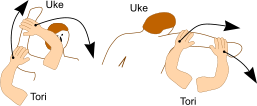

© Malcolm 2022

Ki Aikido Attacks
Basic Attacks (by Uke):
Contact ‘Grabs’:
Katate-dori – Single-hand grab. One hand grabs one wrist (on same side, ie not across body). Katate kosa-dori – Cross hand grab. Ryo-te mochi (or Morote-dori ) – Both-hands grab. Both hands grab one wrist; the lower hand should be on the inside, closer to the Uke’s palm. Ryote-dori – Two hands grab. Both of the Uke’s wrists are held; one by each of the Tori’s hands. Sometimes written as expansion of katate-dori to include both hands, ie ryo-katate-dori. Kata-dori – Shoulder grab. A shoulder grab. "Both-shoulders-grab" is ryo-kata-dori . Mune-dori – Chest grab. Grabbing the (clothing of the) chest.Non-Contact Attacks:
Shomen-uchi – Front-of-the-head strike. A vertical knife-hand strike to the head (but follow through, as if slicing to navel). In training, this is directed at the forehead or the crown for safety. Yokomen-uchi – Side-of-the-head strike. A diagonal knife-hand strike to the side of the head or neck. Mune-tsuki – Chest thrust. A punch to the torso. Targets include the chest, abdomen, and solar plexus. Ganmen-tsuki – Face thrust. A punch to the face.Method of Attack
The uke usually attacks with his/her right hand first so the tori has to present the appropriate hand. This is usually the left hand but for some attacks, katate kosi dori for example, the tori presents their right hand. Moves are repeated on both sides, left and right, to maintain balance. Most moves are practised statically at first, to show the detail of the technique, but once this is mastered they can be done dynamically. In this case, the uke makes the same attack but moving in; the tori will seek to avoid the grab, punch, kick, choke by doing the counter move before the actual grab, punch, etc occurs (but still within the uke’s flow). The uke is an active participant in the move. They should attack realistically but also be compliant and flow with the tori’s counter; ie not be deliberately difficult! To be ‘realistic’: The uke should maintain their ki , ie not lunge forward off balance; The uke should not swing their arm out wide to grab ( dori ) the tori but come in straight, from behind their hip; ‘Grabs’, on wrist or shoulder, should be firm to give the tori something to work with (but not so tight that it hurts); The uke should make a positive attempt to grab the tori’s wrist(s), shoulder etc even if the tori counters in such a way that the grab never actually occurs; Punches ( tsuki ) and strikes ( uchi ) should be centred and with follow through, as if for real, and not off to one side, flabby or prematurely terminated. They may however be made slowly to give the tori a chance to practise their counter moves.Principles:
Ikkyo (pronounced ik-e-o) – first pinning technique – press arm: (thumb over their thumb, 3 rd and 4 th fingers hooked over back of their hand. Other hand on their bicep. Keep Uke’s arm straight; change to nikyo if it bends. Move Uke down to ground) Nikyo (or nikkyo) – second pinning technique – turn wrist: (fingers over uke’s fingers bending hand back on itself, bring uke straight down) Sankyo – third pinning technique – twist wrist, directing upward, spiral tension through arm, elbow and shoulder. (twist wrist so palm faces out, fingers down in front of uke’s chest) Yonkyo – fourth pinning technique – press wrist: (one hand holds uke as for ikkyo; 2 nd hand holds wrist of same uke hand with tori’s first finger first joint pressing into pressure point, radial nerve, on side of uke’s wrist)Actions by Tori:
Irimi – To enter or entering. Move, face into an opponent’s space. Tenshin ( sometimes seen as Tenkan ) – Turning. Moving to the side, outside of an opponent’s space. Tai-no-henka – Blending Kokyu-nage – loose term for various moves that do not use joint locks or twists as used in other techniques. The Tori brings one hand up front of Uke’s body, over face and then comes down, extending ki over Uke’s face, dropping the Uke to the ground without touching them (I wonder if this is why it is called a ‘breath’ throw?). Shiho-nage – known as the 4 direction throw (I think because there are 4 ways Uke can be thrown) but is when the hand is folded back past the shoulder, locking the shoulder joint, and is then brought down to fell the attacker. Rule of thumb is that if uke (or attacker) pulls you toward them then use Irimi ; if they push then use Tenshin .Summary Table of Attacks and Responses
To be added






















